India
From Wikipedia, the free encyclopedia
This article is about the Republic of India. For other uses, see India (disambiguation).
| Republic of India
Bhārat Gaṇarājya
| ||||||
|---|---|---|---|---|---|---|
| ||||||
| Motto: "Satyameva Jayate" (Sanskrit) "Truth Alone Triumphs"[1] | ||||||
| Anthem: Jana Gana Mana "Thou art the rulers of the minds of all people"[2][3] | ||||||
| National song Vande Mataram "I Bow to Thee, Mother"[a][1][3] | ||||||
|
Area controlled by India shown in dark green;
claimed but uncontrolled regions shown in light green. | ||||||
| Capital | New Delhi 28°36.8′N 77°12.5′E | |||||
| Largest city | Mumbai 18°58′30″N 72°49′33″E | |||||
| Official languages | Hindi English[4][5][nb 1] | |||||
| Recognised regional languages | ||||||
| National language | None[9][10] | |||||
| Religion | 79.8% Hinduism 14.2% Islam 2.3% Christianity 1.7% Sikhism 0.7% Buddhism 0.4% Jainism 0.9% others[11][12] | |||||
| Demonym | Indian | |||||
| Government | Federal parliamentary republic[1] | |||||
| • | President | Pranab Mukherjee | ||||
| • | Vice-President | Mohammad Hamid Ansari | ||||
| • | Prime Minister | Narendra Modi | ||||
| • | Chief Justice | T. S. Thakur[13] | ||||
| • | Speaker of the Lower House | Sumitra Mahajan | ||||
| Legislature | Parliament of India | |||||
| • | Upper house | Rajya Sabha | ||||
| • | Lower house | Lok Sabha | ||||
| Independence from the United Kingdom | ||||||
| • | Dominion | 15 August 1947 | ||||
| • | Republic | 26 January 1950 | ||||
| Area | ||||||
| • | Total | 3,287,263[14] km2[b] (7th) 1,269,346 sq mi | ||||
| • | Water (%) | 9.6 | ||||
| Population | ||||||
| • | 2016 estimate | 1,293,057,000[15] (2nd) | ||||
| • | 2011 census | 1,210,854,977[16][17](2nd) | ||||
| • | Density | 388.3/km2 (31st) 1,005.8/sq mi | ||||
| GDP (PPP) | 2016 estimate | |||||
| • | Total | $8.727 trillion[18] (3rd) | ||||
| • | Per capita | $6,664[18] (122nd) | ||||
| GDP (nominal) | 2016 estimate | |||||
| • | Total | $2.384 trillion[18] (7th) | ||||
| • | Per capita | $1,820[18] (141st) | ||||
| Gini (2009) | 33.9[19] medium · 79th | |||||
| HDI (2014) | medium · 130th | |||||
| Currency | Indian rupee (₹) (INR) | |||||
| Time zone | IST (UTC+05:30) | |||||
| DST is not observed | ||||||
| Date format | dd-mm-yyyy | |||||
| Drives on the | left | |||||
| Calling code | +91 | |||||
| ISO 3166 code | IN | |||||
| Internet TLD | .in | |||||
India, officially the Republic of India (IAST: Bhārat Gaṇarājya),[21][22][c] is a country in South Asia. It is the seventh-largest country by area, the second-most populouscountry (with over 1.2 billion people), and the most populous democracy in the world. Bounded by the Indian Ocean on the south, the Arabian Sea on the south-west, and the Bay of Bengal on the south-east, it shares land borders with Pakistan to the west;[d] China, Nepal, and Bhutan to the north-east; and Myanmar (Burma) andBangladesh to the east. In the Indian Ocean, India is in the vicinity of Sri Lanka and the Maldives; in addition, India's Andaman and Nicobar Islands share a maritime border with Thailand and Indonesia.
Home to the ancient Indus Valley Civilisation and a region of historic trade routes and vast empires, the Indian subcontinent was identified with its commercial and cultural wealth for much of its long history.[23] Four religions—Hinduism, Buddhism, Jainism, and Sikhism—originated here, whereas Zoroastrianism, Judaism,Christianity, and Islam arrived in the 1st millennium CE and also shaped the region's diverse culture. Gradually annexed by and brought under the administration of theBritish East India Company from the early 18th century and administered directly by the United Kingdom after the Indian Rebellion of 1857, India became an independent nation in 1947 after a struggle for independence that was marked by non-violent resistance led by Mahatma Gandhi.
Currently, the Indian economy is the world's seventh-largest by nominal GDP and third-largest by purchasing power parity (PPP).[18] Following market-based economic reforms in 1991, India became one of the fastest-growing major economies; it is considered a newly industrialised country. However, it continues to face the challengesof poverty, corruption, malnutrition and inadequate public healthcare. A nuclear weapons state and a regional power, it has the third-largest standing army in the world and ranks sixth in military expenditure among nations. India is a federal republic governed under a parliamentary system and consists of 29 states and 7 union territories. India is a pluralistic, multilingual, and a multi-ethnic society. It is also home to a diversity of wildlife in a variety of protected habitats.
Contents
[hide]Etymology
Main article: Names of India
The name India is derived from Indus, which originates from the Old Persian word Sindhi.[24] The latter term stems from the Sanskrit word Sindhu, which was the historical local appellation for the Indus River.[25] The ancient Greeks referred to the Indians as Indoi (Ινδοί), which translates as "The people of the Indus".[26]
The geographical term Bharat (Bhārat, pronounced [ˈbʱaːrət̪] ( listen)), which is recognised by the Constitution of India as an official name for the country,[27] is used bymany Indian languages in its variations. It is a modernisation of the historical name Bharatavarsha, which gained increasing currency from the mid-19th century onwards as a native name of India.[21] Scholars believe it to be named after the Vedic tribe of Bharatas in the second millennium B.C.E.[28] It is also traditionally associated with the rule of the legendary emperor Bharata.[29] Gaṇarājya (literally, people's State) is the Sanskrit/Hindi term for "republic" dating back to the ancient times.[30][31][32]
listen)), which is recognised by the Constitution of India as an official name for the country,[27] is used bymany Indian languages in its variations. It is a modernisation of the historical name Bharatavarsha, which gained increasing currency from the mid-19th century onwards as a native name of India.[21] Scholars believe it to be named after the Vedic tribe of Bharatas in the second millennium B.C.E.[28] It is also traditionally associated with the rule of the legendary emperor Bharata.[29] Gaṇarājya (literally, people's State) is the Sanskrit/Hindi term for "republic" dating back to the ancient times.[30][31][32]
Hindustan ([ɦɪnd̪ʊˈst̪aːn] ( listen)) is an ancient Persian name for India dating to 3 century B.C.E. It was introduced into India by the Mughals and widely used since then, often being thought of as the "Land of the Hindus." Its meaning varied, referring to a region that encompassed northern India and Pakistan or India in its entirety.[21][33][34]
listen)) is an ancient Persian name for India dating to 3 century B.C.E. It was introduced into India by the Mughals and widely used since then, often being thought of as the "Land of the Hindus." Its meaning varied, referring to a region that encompassed northern India and Pakistan or India in its entirety.[21][33][34]
History
Main articles: History of India and History of the Republic of India
Ancient India
The earliest authenticated human remains in South Asia date to about 30,000 years ago.[35] Nearly contemporaneous Mesolithic rock art sites have been found in many parts of the Indian subcontinent, including at the Bhimbetka rock shelters in Madhya Pradesh.[36] Around 7000 BCE, the first known Neolithic settlements appeared on the subcontinent in Mehrgarh and other sites in western Pakistan.[37] These gradually developed into the Indus Valley Civilisation,[38] the first urban culture in South Asia;[39] it flourished during 2500–1900 BCE in Pakistan and western India.[40] Centred around cities such as Mohenjo-daro, Harappa, Dholavira, and Kalibangan, and relying on varied forms of subsistence, the civilisation engaged robustly in crafts production and wide-ranging trade.[39]
During the period 2000–500 BCE, in terms of culture, many regions of the subcontinent transitioned from the Chalcolithic to the Iron Age.[41] The Vedas, the oldest scriptures of Hinduism,[42] were composed during this period,[43] and historians have analysed these to posit a Vedic culture in the Punjab region and the upper Gangetic Plain.[41] Most historians also consider this period to have encompassed several waves of Indo-Aryan migration into the subcontinent.[44][42] The caste system arose during this period, creating a hierarchy of priests, warriors, free peasants and traders, and lastly the indigenous peoples who were regarded as impure; and small tribal units gradually coalesced into monarchical, state-level polities.[45][46] On the Deccan Plateau, archaeological evidence from this period suggests the existence of a chiefdom stage of political organisation.[41] In southern India, a progression to sedentary life is indicated by the large number of megalithic monuments dating from this period,[47] as well as by nearby traces of agriculture, irrigation tanks, and craft traditions.[47]
In the late Vedic period, around the 6th century BCE, the small states and chiefdoms of the Ganges Plain and the north-western regions had consolidated into 16 major oligarchies and monarchies that were known as the mahajanapadas.[48][49] The emerging urbanisation gave rise to non-Vedic religious movements, two of which became independent religions. Jainism came into prominence during the life of its exemplar, Mahavira.[50] Buddhism, based on the teachings of Gautama Buddhaattracted followers from all social classes excepting the middle class; chronicling the life of the Buddha was central to the beginnings of recorded history in India.[51][52][53] In an age of increasing urban wealth, both religions held up renunciation as an ideal,[54] and both established long-lasting monastic traditions. Politically, by the 3rd century BCE, the kingdom of Magadha had annexed or reduced other states to emerge as the Mauryan Empire.[55] The empire was once thought to have controlled most of the subcontinent excepting the far south, but its core regions are now thought to have been separated by large autonomous areas.[56][57] The Mauryan kings are known as much for their empire-building and determined management of public life as for Ashoka's renunciation of militarism and far-flung advocacy of the Buddhist dhamma.[58][59]
The Sangam literature of the Tamil language reveals that, between 200 BCE and 200 CE, the southern peninsula was being ruled by the Cheras, the Cholas, and the Pandyas, dynasties that traded extensively with the Roman Empire and with West and South-East Asia.[60][61] In North India, Hinduism asserted patriarchal control within the family, leading to increased subordination of women.[62][55] By the 4th and 5th centuries, the Gupta Empire had created in the greater Ganges Plain a complex system of administration and taxation that became a model for later Indian kingdoms.[63][64] Under the Guptas, a renewed Hinduism based on devotion rather than the management of ritual began to assert itself.[65] The renewal was reflected in a flowering of sculpture and architecture, which found patrons among an urban elite.[64] Classical Sanskrit literature flowered as well, and Indian science,astronomy, medicine, and mathematics made significant advances.[64]
Medieval India
The Indian early medieval age, 600 CE to 1200 CE, is defined by regional kingdoms and cultural diversity.[66] When Harsha of Kannauj, who ruled much of the Indo-Gangetic Plain from 606 to 647 CE, attempted to expand southwards, he was defeated by the Chalukya ruler of the Deccan.[67] When his successor attempted to expand eastwards, he was defeated by the Pala king of Bengal.[67] When the Chalukyas attempted to expand southwards, they were defeated by the Pallavas from farther south, who in turn were opposed by the Pandyasand the Cholas from still farther south.[67] No ruler of this period was able to create an empire and consistently control lands much beyond his core region.[66] During this time, pastoral peoples whose land had been cleared to make way for the growing agricultural economy were accommodated within caste society, as were new non-traditional ruling classes.[68] The caste system consequently began to show regional differences.[68]
In the 6th and 7th centuries, the first devotional hymns were created in the Tamil language.[69] They were imitated all over India and led to both the resurgence of Hinduism and the development of all modern languages of the subcontinent.[69] Indian royalty, big and small, and the temples they patronised, drew citizens in great numbers to the capital cities, which became economic hubs as well.[70] Temple towns of various sizes began to appear everywhere as India underwent another urbanisation.[70] By the 8th and 9th centuries, the effects were felt in South-East Asia, as South Indian culture and political systems were exported to lands that became part of modern-day Myanmar, Thailand, Laos, Cambodia, Vietnam,Philippines, Malaysia, and Java.[71] Indian merchants, scholars, and sometimes armies were involved in this transmission; South-East Asians took the initiative as well, with many sojourning in Indian seminaries and translating Buddhist and Hindu texts into their languages.[71]
After the 10th century, Muslim Central Asian nomadic clans, using swift-horse cavalry and raising vast armies united by ethnicity and religion, repeatedly overran South Asia's north-western plains, leading eventually to the establishment of the Islamic Delhi Sultanate in 1206.[72] The sultanate was to control much of North India, and to make many forays into South India. Although at first disruptive for the Indian elites, the sultanate largely left its vast non-Muslim subject population to its own laws and customs.[73][74] By repeatedly repulsing Mongol raiders in the 13th century, the sultanate saved India from the devastation visited on West and Central Asia, setting the scene for centuries of migration of fleeing soldiers, learned men, mystics, traders, artists, and artisans from that region into the subcontinent, thereby creating a syncretic Indo-Islamic culture in the north.[75][76] The sultanate's raiding and weakening of the regional kingdoms of South India paved the way for the indigenous Vijayanagara Empire.[77] Embracing a strong Shaivite tradition and building upon the military technology of the sultanate, the empire came to control much of peninsular India,[78] and was to influence South Indian society for long afterwards.[77]
Early modern India
In the early 16th century, northern India, being then under mainly Muslim rulers,[79] fell again to the superior mobility and firepower of a new generation of Central Asian warriors.[80]The resulting Mughal Empire did not stamp out the local societies it came to rule, but rather balanced and pacified them through new administrative practices[81][82] and diverse and inclusive ruling elites,[83] leading to more systematic, centralised, and uniform rule.[84] Eschewing tribal bonds and Islamic identity, especially under Akbar, the Mughals united their far-flung realms through loyalty, expressed through a Persianised culture, to an emperor who had near-divine status.[83] The Mughal state's economic policies, deriving most revenues from agriculture[85] and mandating that taxes be paid in the well-regulated silver currency,[86] caused peasants and artisans to enter larger markets.[84] The relative peace maintained by the empire during much of the 17th century was a factor in India's economic expansion,[84] resulting in greater patronage of painting, literary forms, textiles, and architecture.[87]Newly coherent social groups in northern and western India, such as the Marathas, the Rajputs, and the Sikhs, gained military and governing ambitions during Mughal rule, which, through collaboration or adversity, gave them both recognition and military experience.[88] Expanding commerce during Mughal rule gave rise to new Indian commercial and political elites along the coasts of southern and eastern India.[88] As the empire disintegrated, many among these elites were able to seek and control their own affairs.[89]
By the early 18th century, with the lines between commercial and political dominance being increasingly blurred, a number of European trading companies, including the English East India Company, had established coastal outposts.[90][91] The East India Company's control of the seas, greater resources, and more advanced military training and technology led it to increasingly flex its military muscle and caused it to become attractive to a portion of the Indian elite; both these factors were crucial in allowing the Company to gain control over theBengal region by 1765 and sideline the other European companies.[92][90][93][94] Its further access to the riches of Bengal and the subsequent increased strength and size of its army enabled it to annex or subdue most of India by the 1820s.[95] India was then no longer exporting manufactured goods as it long had, but was instead supplying the British Empire with raw materials, and many historians consider this to be the onset of India's colonial period.[90] By this time, with its economic power severely curtailed by the British parliament and itself effectively made an arm of British administration, the Company began to more consciously enter non-economic arenas such as education, social reform, and culture.[96]
Modern India
Historians consider India's modern age to have begun sometime between 1848 and 1885. The appointment in 1848 of Lord Dalhousie as Governor General of the East India Company set the stage for changes essential to a modern state. These included the consolidation and demarcation of sovereignty, the surveillance of the population, and the education of citizens (English Education Act 1835). Technological changes—among them, railways, canals, and the telegraph—were introduced not long after their introduction in Europe.[97][98][99][100] However, disaffection with the Company also grew during this time, and set off the Indian Rebellion of 1857. Fed by diverse resentments and perceptions, including invasive British-style social reforms, harsh land taxes, and summary treatment of some rich landowners and princes, the rebellion rocked many regions of northern and central India and shook the foundations of Company rule.[101][102] Although the rebellion was suppressed by 1858, it led to the dissolution of the East India Company and to the direct administration of India by the British government. Proclaiming a unitary state and a gradual but limited British-style parliamentary system, the new rulers also protected princes and landed gentry as a feudal safeguard against future unrest.[103][104] In the decades following, public life gradually emerged all over India, leading eventually to the founding of the Indian National Congress in 1885.[105][106][107][108]
The rush of technology and the commercialisation of agriculture in the second half of the 19th century was marked by economic setbacks—many small farmers became dependent on the whims of far-away markets.[109] There was an increase in the number of large-scale famines,[110] and, despite the risks of infrastructure development borne by Indian taxpayers, little industrial employment was generated for Indians.[111] There were also salutary effects: commercial cropping, especially in the newly canalled Punjab, led to increased food production for internal consumption.[112] The railway network provided critical famine relief,[113] notably reduced the cost of moving goods,[113] and helped nascent Indian-owned industry.[112] After World War I, in which approximately one million Indians served,[114] a new period began. It was marked by British reforms but also repressive legislations, by more strident Indian calls for self-rule, and by the beginnings of anonviolent movement of non-co-operation, of which Mohandas Karamchand Gandhi would become the leader and enduring symbol.[115] During the 1930s, slow legislative reform was enacted by the British; the Indian National Congress won victories in the resulting elections.[116] The next decade was beset with crises: Indian participation in World War II, the Congress's final push for non-co-operation, and an upsurge of Muslim nationalism. All were capped by the advent of independence in 1947, but tempered by thepartition of India into two states: India and Pakistan.[117]
Vital to India's self-image as an independent nation was its constitution, completed in 1950, which put in place a secular and democratic republic.[118] In the 60 years since, India has had a mixed record of successes and failures.[119] It has remained a democracy with civil liberties, an active Supreme Court, and a largely independent press.[119]Economic liberalisation, which was begun in the 1990s, has created a large urban middle class, transformed India into one of the world's fastest-growing economies,[120] and increased its geopolitical clout. Indian movies, music, and spiritual teachings play an increasing role in global culture.[119] Yet, India is also shaped by seemingly unyielding poverty, both rural and urban;[119] by religious and caste-related violence;[121] byMaoist-inspired Naxalite insurgencies;[122] and by separatism in Jammu and Kashmir and in Northeast India.[123] It has unresolved territorial disputes with China[124] and with Pakistan.[124] The India–Pakistan nuclear rivalry came to a head in 1998.[125] India's sustained democratic freedoms are unique among the world's newer nations; however, in spite of its recent economic successes, freedom from want for its disadvantaged population remains a goal yet to be achieved.[126]
Geography
Main article: Geography of India
India comprises the bulk of the Indian subcontinent, lying atop the Indian tectonic plate, and part of the Indo-Australian Plate.[127] India's defining geological processes began 75 million years ago when the Indian plate, then part of the southern supercontinent Gondwana, began a north-eastward drift caused by seafloor spreading to its south-west, and later, south and south-east.[127] Simultaneously, the vast Tethyn oceanic crust, to its northeast, began to subduct under the Eurasian plate.[127] These dual processes, driven by convection in the Earth's mantle, both created the Indian Ocean and caused the Indian continental crust eventually to under-thrust Eurasia and to uplift theHimalayas.[127] Immediately south of the emerging Himalayas, plate movement created a vast trough that rapidly filled with river-borne sediment[128] and now constitutes theIndo-Gangetic Plain.[129] Cut off from the plain by the ancient Aravalli Range lies the Thar Desert.[130]
The original Indian plate survives as peninsular India, the oldest and geologically most stable part of India. It extends as far north as the Satpura and Vindhya ranges in central India. These parallel chains run from the Arabian Sea coast in Gujarat in the west to the coal-rich Chota Nagpur Plateau in Jharkhand in the east.[131] To the south, the remaining peninsular landmass, the Deccan Plateau, is flanked on the west and east by coastal ranges known as the Western and Eastern Ghats;[132] the plateau contains the country's oldest rock formations, some over one billion years old. Constituted in such fashion, India lies to the north of the equator between 6° 44' and 35° 30' north latitude[e]and 68° 7' and 97° 25' east longitude.[133]
India's coastline measures 7,517 kilometres (4,700 mi) in length; of this distance, 5,423 kilometres (3,400 mi) belong to peninsular India and 2,094 kilometres (1,300 mi) to the Andaman, Nicobar, and Lakshadweep island chains.[134] According to the Indian naval hydrographic charts, the mainland coastline consists of the following: 43% sandy beaches; 11% rocky shores, including cliffs; and 46% mudflats or marshy shores.[134]
Major Himalayan-origin rivers that substantially flow through India include the Ganges and the Brahmaputra, both of which drain into the Bay of Bengal.[135] Important tributaries of the Ganges include the Yamuna and the Kosi; the latter's extremely low gradient often leads to severe floods and course changes.[136] Major peninsular rivers, whose steeper gradients prevent their waters from flooding, include the Godavari, the Mahanadi, the Kaveri, and the Krishna, which also drain into the Bay of Bengal;[137] and the Narmada and the Tapti, which drain into the Arabian Sea.[138] Coastal features include the marshy Rann of Kutch of western India and the alluvial Sundarbans delta of eastern India; the latter is shared with Bangladesh.[139] India has two archipelagos: the Lakshadweep, coral atolls off India's south-western coast; and the Andaman and Nicobar Islands, a volcanic chain in the Andaman Sea.[140]
The Indian climate is strongly influenced by the Himalayas and the Thar Desert, both of which drive the economically and culturally pivotal summer and winter monsoons.[141]The Himalayas prevent cold Central Asian katabatic winds from blowing in, keeping the bulk of the Indian subcontinent warmer than most locations at similar latitudes.[142][143]The Thar Desert plays a crucial role in attracting the moisture-laden south-west summer monsoon winds that, between June and October, provide the majority of India's rainfall.[141] Four major climatic groupings predominate in India: tropical wet, tropical dry, subtropical humid, and montane.[144]
Biodiversity
Main article: Wildlife of India
India lies within the Indomalaya ecozone and contains three biodiversity hotspots.[145] One of 17 megadiverse countries, it hosts 8.6% of all mammalian, 13.7% of all avian, 7.9% of all reptilian, 6% of all amphibian, 12.2% of all piscine, and 6.0% of all flowering plant species.[146][147] About 21.2% of the country's landmass is covered by forests (tree canopy density >10%), of which 12.2% comprises moderately or very dense forests (tree canopy density >40%).[148] Endemism is high among plants, 33%, and amongecoregions such as the shola forests.[149] Habitat ranges from the tropical rainforest of the Andaman Islands, Western Ghats, and North-East India to the coniferous forest of the Himalaya. Between these extremes lie the moist deciduous sal forest of eastern India; the dry deciduous teak forest of central and southern India; and the babul-dominatedthorn forest of the central Deccan and western Gangetic plain.[150] The medicinal neem, widely used in rural Indian herbal remedies, is a key Indian tree. The luxuriant pipal fig tree, shown on the seals of Mohenjo-daro, shaded Gautama Buddha as he sought enlightenment.
Many Indian species descend from taxa originating in Gondwana, from which the Indian plate separated more than 105 million years before present.[151] Peninsular India's subsequent movement towards and collision with the Laurasian landmass set off a mass exchange of species. Epochal volcanism and climatic changes 20 million years ago forced a mass extinction.[152] Mammals then entered India from Asia through two zoogeographical passes flanking the rising Himalaya.[150] Thus, while 45.8% of reptiles and 55.8% of amphibians are endemic, only 12.6% of mammals and 4.5% of birds are.[147] Among them are the Nilgiri leaf monkey and Beddome's toad of the Western Ghats. India contains 172 IUCN-designated threatened animal species, or 2.9% of endangered forms.[153] These include the Asiatic lion, the Bengal tiger, the snow leopard and theIndian white-rumped vulture, which, by ingesting the carrion of diclofenac-laced cattle, nearly became extinct.
The pervasive and ecologically devastating human encroachment of recent decades has critically endangered Indian wildlife. In response the system of national parks and protected areas, first established in 1935, was substantially expanded. In 1972, India enacted the Wildlife Protection Act[154] and Project Tiger to safeguard crucial wilderness; the Forest Conservation Act was enacted in 1980 and amendments added in 1988.[155] India hosts more than five hundred wildlife sanctuaries and thirteen biosphere reserves,[156] four of which are part of the World Network of Biosphere Reserves; twenty-five wetlands are registered under the Ramsar Convention.[157]
Politics
Main article: Politics of India
India is the world's most populous democracy.[158] A parliamentary republic with a multi-party system,[159] it has six recognised national parties, including the Indian National Congress and the Bharatiya Janata Party (BJP), and more than 40 regional parties.[160] The Congress is considered centre-left in Indian political culture,[161] and the BJP right-wing.[162][163][164] For most of the period between 1950—when India first became a republic—and the late 1980s, the Congress held a majority in the parliament. Since then, however, it has increasingly shared the political stage with the BJP,[165] as well as with powerful regional parties which have often forced the creation of multi-party coalitions at the centre.[166]
In the Republic of India's first three general elections, in 1951, 1957, and 1962, the Jawaharlal Nehru-led Congress won easy victories. On Nehru's death in 1964, Lal Bahadur Shastri briefly became prime minister; he was succeeded, after his own unexpected death in 1966, by Indira Gandhi, who went on to lead the Congress to election victories in 1967 and 1971. Following public discontent with the state of emergency she declared in 1975, the Congress was voted out of power in 1977; the then-new Janata Party, which had opposed the emergency, was voted in. Its government lasted just over three years. Voted back into power in 1980, the Congress saw a change in leadership in 1984, when Indira Gandhi was assassinated; she was succeeded by her son Rajiv Gandhi, who won an easy victory in the general elections later that year. The Congress was voted out again in 1989 when a National Front coalition, led by the newly formed Janata Dal in alliance with the Left Front, won the elections; that government too proved relatively short-lived, lasting just under two years.[167] Elections were held again in 1991; no party won an absolute majority. The Congress, as the largest single party, was able to form a minority government led by P. V. Narasimha Rao.[168]
A two-year period of political turmoil followed the general election of 1996. Several short-lived alliances shared power at the centre. The BJP formed a government briefly in 1996; it was followed by two comparatively long-lasting United Front coalitions, which depended on external support. In 1998, the BJP was able to form a successful coalition, the National Democratic Alliance (NDA). Led by Atal Bihari Vajpayee, the NDA became the first non-Congress, coalition government to complete a five-year term.[169] In the2004 Indian general elections, again no party won an absolute majority, but the Congress emerged as the largest single party, forming another successful coalition: the United Progressive Alliance (UPA). It had the support of left-leaning parties and MPs who opposed the BJP. The UPA returned to power in the 2009 general election with increased numbers, and it no longer required external support from India's communist parties.[170] That year, Manmohan Singh became the first prime minister since Jawaharlal Nehru in1957 and 1962 to be re-elected to a consecutive five-year term.[171] In the 2014 general election, the BJP became the first political party since 1984 to win a majority and govern without the support of other parties.[172] The Prime Minister of India is Narendra Modi, who was formerly Chief Minister of Gujarat.
Government
Main articles: Government of India and Constitution of India
India is a federation with a parliamentary system governed under the Constitution of India, which serves as the country's supreme legal document. It is a republic and representative democracy, in which "majority rule is tempered by minority rights protected by law". Federalism in India defines the power distribution between the federal government and the states. The government abides by constitutional checks and balances. The Constitution of India, which came into effect on 26 January 1950,[173] states in its preamble that India is a sovereign, socialist, secular, democratic republic.[174] India's form of government, traditionally described as "quasi-federal" with a strong centre and weak states,[175] has grown increasingly federal since the late 1990s as a result of political, economic, and social changes.[176][177]
| Flag | Tiranga (Tricolour) |
|---|---|
| Emblem | Sarnath Lion Capital |
| Anthem | Jana Gana Mana |
| Song | Vande Mataram |
| Currency | ₹ (Indian rupee) |
| Calendar | Saka |
| Animal | Tiger (land) River dolphin (aquatic) |
| Bird | Indian peafowl |
| Flower | Lotus |
| Fruit | Mango |
| Tree | Banyan |
| River | Ganga |
| Game | Not declared[178] |
The federal government comprises three branches:
- Executive: The President of India is the head of state[179] and is elected indirectly by a national electoral college[180] for a five-year term.[181] The Prime Minister of India is the head of government and exercises most executive power.[182] Appointed by the president,[183] the prime minister is by convention supported by the partyor political alliance holding the majority of seats in the lower house of parliament.[182] The executive branch of the Indian government consists of the president, the vice-president, and the Council of Ministers—the cabinet being its executive committee—headed by the prime minister. Any minister holding a portfolio must be a member of one of the houses of parliament.[179] In the Indian parliamentary system, the executive is subordinate to the legislature; the prime minister and his council are directly responsible to the lower house of the parliament.[184]
- Legislative: The legislature of India is the bicameral parliament. It operates under a Westminster-style parliamentary system and comprises the upper house called theRajya Sabha ("Council of States") and the lower called the Lok Sabha ("House of the People").[185] The Rajya Sabha is a permanent body that has 245 members who serve in staggered six-year terms.[186] Most are elected indirectly by the state and territorial legislatures in numbers proportional to their state's share of the national population.[183] All but two of the Lok Sabha's 545 members are directly elected by popular vote; they represent individual constituencies via five-year terms.[187] The remaining two members are nominated by the president from among the Anglo-Indian community, in case the president decides that they are not adequately represented.[188]
- Judicial: India has a unitary three-tier independent judiciary[189] that comprises the Supreme Court, headed by the Chief Justice of India, 24 High Courts, and a large number of trial courts.[189] The Supreme Court has original jurisdiction over cases involving fundamental rights and over disputes between states and the centre; it hasappellate jurisdiction over the High Courts.[190] It has the power both to declare the law and to strike down union or state laws which contravene the constitution,[191] as well as to invalidate any government action it deems unconstitutional.[192]
Subdivisions
Main article: Administrative divisions of India
See also: Political integration of India
| 1. Andhra Pradesh | 10. Jammu and Kashmir | 19. Nagaland | 28. Uttarakhand |
| 2. Arunachal Pradesh | 11. Jharkhand | 20. Odisha | 29. West Bengal |
| 3. Assam | 12. Karnataka | 21. Punjab | A. Andaman and Nicobar Islands |
| 4. Bihar | 13. Kerala | 22. Rajasthan | B. Chandigarh |
| 5. Chhattisgarh | 14. Madhya Pradesh | 23. Sikkim | C. Dadra and Nagar Haveli |
| 6. Goa | 15. Maharashtra | 24. Tamil Nadu | D. Daman and Diu |
| 7. Gujarat | 16. Manipur | 25. Telangana | E. Lakshadweep |
| 8. Haryana | 17. Meghalaya | 26. Tripura | F. National Capital Territory of Delhi |
| 9. Himachal Pradesh | 18. Mizoram | 27. Uttar Pradesh | G. Puducherry |
India is a federation composed of 29 states and 7 union territories.[193] All states, as well as the union territories of Puducherry and the National Capital Territory of Delhi, have elected legislatures and governments, both patterned on the Westminster model. The remaining five union territories are directly ruled by the centre through appointed administrators. In 1956, under the States Reorganisation Act, states were reorganised on a linguistic basis.[194] Since then, their structure has remained largely unchanged. Each state or union territory is further divided into administrative districts. The districts in turn are further divided into tehsils and ultimately into villages.
Foreign relations and military
Main articles: Foreign relations of India and Indian Armed Forces
Since its independence in 1947, India has maintained cordial relations with most nations. In the 1950s, it strongly supported decolonisation in Africa and Asia and played a lead role in the Non-Aligned Movement.[195] In the late 1980s, the Indian military twice intervened abroad at the invitation of neighbouring countries: a peace-keeping operation in Sri Lanka between 1987 and 1990; and an armed intervention to prevent a 1988 coup d'état attempt in Maldives. India has tense relations with neighbouring Pakistan; the two nations have gone to war four times: in 1947, 1965, 1971, and 1999. Three of these wars were fought over the disputed territory of Kashmir, while the fourth, the 1971 war, followed from India's support for the independence of Bangladesh.[196] After waging the 1962 Sino-Indian War and the 1965 war with Pakistan, India pursued close military and economic ties with the Soviet Union; by the late 1960s, the Soviet Union was its largest arms supplier.[197]
Aside from ongoing strategic relations with Russia, India has wide-ranging defence relations with Israel and France. In recent years, it has played key roles in the South Asian Association for Regional Cooperation and the World Trade Organisation. The nation has provided 100,000 military and police personnel to serve in 35 UN peacekeeping operations across four continents. It participates in the East Asia Summit, the G8+5, and other multilateral forums.[198] India has close economic ties with South America,[199]Asia, and Africa; it pursues a "Look East" policy that seeks to strengthen partnerships with the ASEAN nations, Japan, and South Korea that revolve around many issues, but especially those involving economic investment and regional security.[200][201]
China's nuclear test of 1964, as well as its repeated threats to intervene in support of Pakistan in the 1965 war, convinced India to develop nuclear weapons.[202] India conducted its first nuclear weapons test in 1974 and carried out further underground testing in 1998. Despite criticism and military sanctions, India has signed neither the Comprehensive Nuclear-Test-Ban Treaty nor the Nuclear Non-Proliferation Treaty, considering both to be flawed and discriminatory.[203]India maintains a "no first use" nuclear policy and is developing a nuclear triad capability as a part of its "minimum credible deterrence" doctrine.[204][205] It is developing aballistic missile defence shield and, in collaboration with Russia, a fifth-generation fighter jet.[206] Other indigenous military projects involve the design and implementation ofVikrant-class aircraft carriers and Arihant-class nuclear submarines.[206]
Since the end of the Cold War, India has increased its economic, strategic, and military co-operation with the United States and the European Union.[207] In 2008, a civilian nuclear agreement was signed between India and the United States. Although India possessed nuclear weapons at the time and was not party to the Nuclear Non-Proliferation Treaty, it received waivers from the International Atomic Energy Agency and the Nuclear Suppliers Group, ending earlier restrictions on India's nuclear technology and commerce. As a consequence, India became the sixth de facto nuclear weapons state.[208] India subsequently signed co-operation agreements involving civilian nuclear energy with Russia,[209] France,[210] the United Kingdom,[211] and Canada.[212]
The President of India is the supreme commander of the nation's armed forces; with 1.325 million active troops, they compose the world's third-largest military.[213] It comprises the Indian Army, the Indian Navy, and the Indian Air Force; auxiliary organisations include the Strategic Forces Command and three paramilitary groups: the Assam Rifles, the Special Frontier Force, and the Indian Coast Guard.[214] The official Indiandefence budget for 2011 was US$36.03 billion, or 1.83% of GDP.[215] For the fiscal year spanning 2012–2013, US$40.44 billion was budgeted.[216] According to a 2008 SIPRI report, India's annual military expenditure in terms of purchasing power stood at US$72.7 billion.[217] In 2011, the annual defence budget increased by 11.6%,[218] although this does not include funds that reach the military through other branches of government.[219] As of 2012, India is the world's largest arms importer; between 2007 and 2011, it accounted for 10% of funds spent on international arms purchases.[220] Much of the military expenditure was focused on defence against Pakistan and countering growing Chinese influence in the Indian Ocean.[218]
Economy
Main article: Economy of India
See also: Economic History of India and Economic development in India
According to the International Monetary Fund (IMF), the Indian economy in 2015 was nominally worth US$2.183 trillion; it is the 7th-largest economy by market exchange rates, and is, at US$8.027 trillion, the third-largest by purchasing power parity, or PPP.[18] With its average annual GDP growth rate of 5.8% over the past two decades, and reaching 6.1% during 2011–12,[221] India is one of the world's fastest-growing economies.[222] However, the country ranks 140th in the world in nominal GDP per capita and 129th in GDP per capita at PPP.[223] Until 1991, all Indian governments followed protectionist policies that were influenced by socialist economics. Widespread state intervention and regulation largely walled the economy off from the outside world. An acute balance of payments crisis in 1991 forced the nation to liberalise its economy;[224]since then it has slowly moved towards a free-market system[225][226] by emphasising both foreign trade and direct investment inflows.[227] India's recent economic model is largely capitalist.[226] India has been a member of WTO since 1 January 1995.[228]
The 486.6-million worker Indian labour force is the world's second-largest, as of 2011.[214] The service sector makes up 55.6% of GDP, the industrial sector 26.3% and the agricultural sector 18.1%. India's foreign exchange remittances were US$70 billion in year 2014, the largest in the world, contributed to its economy by 25 million Indians working in foreign countries.[229] Major agricultural products include rice, wheat, oilseed, cotton, jute, tea, sugarcane, and potatoes.[193] Major industries include textiles, telecommunications, chemicals, pharmaceuticals, biotechnology, food processing, steel, transport equipment, cement, mining, petroleum, machinery, and software.[193] In 2006, the share of external trade in India's GDP stood at 24%, up from 6% in 1985.[225] In 2008, India's share of world trade was 1.68%;[230] In 2011, India was the world'stenth-largest importer and the nineteenth-largest exporter.[231] Major exports include petroleum products, textile goods, jewellery, software, engineering goods, chemicals, and leather manufactures.[193] Major imports include crude oil, machinery, gems, fertiliser, and chemicals.[193] Between 2001 and 2011, the contribution of petrochemical and engineering goods to total exports grew from 14% to 42%.[232] India was the second largest textile exporter after China in the world in calendar year 2013.[233]
Averaging an economic growth rate of 7.5% for several years prior to 2007,[225] India has more than doubled its hourly wage rates during the first decade of the 21st century.[234] Some 431 million Indians have left poverty since 1985; India's middle classes are projected to number around 580 million by 2030.[235] Though ranking 51st in global competitiveness, India ranks 17th in financial market sophistication, 24th in the banking sector, 44th in business sophistication, and 39th in innovation, ahead of several advanced economies, as of 2010.[236] With 7 of the world's top 15 information technology outsourcing companies based in India, the country is viewed as the second-most favourable outsourcing destination after the United States, as of 2009.[237] India's consumer market, the world's eleventh-largest, is expected to become fifth-largest by 2030.[235]
Driven by growth, India's nominal GDP per capita has steadily increased from US$329 in 1991, when economic liberalisation began, to US$1,265 in 2010, and is estimated to increase to US$2,110 by 2016; however, it has remained lower than those of other Asian developing countries such as Indonesia, Malaysia, Philippines, Sri Lanka, and Thailand, and is expected to remain so in the near future. However, it is higher than Pakistan, Nepal, Afghanistan, Bangladesh and others.[238]
According to a 2011 PricewaterhouseCoopers report, India's GDP at purchasing power parity could overtake that of the United States by 2045.[239] During the next four decades, Indian GDP is expected to grow at an annualised average of 8%, making it potentially the world's fastest-growing major economy until 2050.[239] The report highlights key growth factors: a young and rapidly growing working-age population; growth in the manufacturing sector because of rising education and engineering skill levels; and sustained growth of the consumer market driven by a rapidly growing middle class.[239] The World Bank cautions that, for India to achieve its economic potential, it must continue to focus on public sector reform, transport infrastructure, agricultural and rural development, removal of labour regulations, education, energy security, and public health and nutrition.[240]
In 2016, the Economist Intelligence Unit (EIU) released Top 10 cheapest cities in the world which 4 of it were from India: Bangalore (2nd), Mumbai (3rd), Chennai (6th) and New Delhi (8th) based on the cost of 160 products and services.[241]
Sectors
India's telecommunication industry, the world's fastest-growing, added 227 million subscribers during the period 2010–11,[242] and after the first quarter of 2013, India surpassed Japan to become the third largest smartphone market in the world after China and the US[243]
Its automotive industry, the world's second fastest growing, increased domestic sales by 26% during 2009–10,[244] and exports by 36% during 2008–09.[245] India's capacity to generate electrical power is 250 gigawatts, of which 8% is renewable. At the end of 2011, the Indian IT industry employed 2.8 million professionals, generated revenues close to US$100 billion equalling 7.5% of Indian GDP and contributed 26% of India's merchandise exports.[246]
The pharmaceutical industry in India is among the significant emerging markets for global pharma industry. The Indian pharmaceutical market is expected to reach $48.5 billion by 2020. India's R & D spending constitutes 60% of the biopharmaceutical industry.[247][248] India is among the top 12 biotech destinations of the world.[249][250] The Indian biotech industry grew by 15.1% in 2012–13, increasing its revenues from 204.4 Billion INR (Indian Rupees) to 235.24 Billion INR (3.94 B US$ - exchange rate June 2013: 1 US$ approx. 60 INR).[251] Although hardly 2% of Indians pay income taxes.[252]
Poverty
Main article: Poverty in India
Despite impressive economic growth during recent decades, India continues to face socio-economic challenges. India contains the largest concentration of people living below the World Bank's international poverty line of US$1.25 per day,[253] the proportion having decreased from 60% in 1981 to 42% in 2005, and 25% in 2011.[254] 30.7% of India's children under the age of five are underweight.[255] According to a Food and Agriculture Organization report in 2015, 15% of Indian population is undernourished.[256][257] TheMid-Day Meal Scheme attempts to lower these rates.[258] Since 1991, economic inequality between India's states has consistently grown: the per-capita net state domestic product of the richest states in 2007 was 3.2 times that of the poorest.[259] Corruption in India is perceived to have increased significantly,[260] with one report estimating the illegal capital flows since independence to be US$462 billion.[261]
India has the highest number of people living in conditions of slavery, 18 million, most of whom are in bonded labour.[262] India has the largest number of child labourers under the age of 14 in the world with an estimated 12.6 million children engaged in hazardous occupations.[263][264][265]
Demographics
Main article: Demographics of India
See also: Languages of India and Religion in India
With 1,210,193,422 residents reported in the 2011 provisional census report,[266] India is the world's second-most populous country. Its population grew by 17.64% during 2001–2011,[267] compared to 21.54% growth in the previous decade (1991–2001).[267] The human sex ratio, according to the 2011 census, is 940 females per 1,000 males.[266] The median age was 24.9 in the 2001 census.[214] The first post-colonial census, conducted in 1951, counted 361.1 million people.[268] Medical advances made in the last 50 years as well as increased agricultural productivity brought about by the "Green Revolution" have caused India's population to grow rapidly.[269] India continues to face several public health-related challenges.[270][271]
Life expectancy in India is at 68 years with life expectancy for women being 69.6 years and for men being 67.3.[272] There are around 50 physicians per 100,000 Indians.[273] The number of Indians living in urban areas has grown by 31.2% between 1991 and 2001.[274] Yet, in 2001, over 70% lived in rural areas.[275][276] The level of urbanisation increased from 27.81% in 2001 Census to 31.16% in 2011 Census. The slowing down of the overall growth rate of population was due to the sharp decline in the growth rate in rural areas since 1991.[277] According to the 2011 census, there are 53 million-plus cities in India; among them Mumbai, Delhi, Bangalore, Hyderabad, Chennai, Ahmedabad, and Kolkata, in decreasing order by population.[278] The literacy rate in 2011 was 74.04%: 65.46% among females and 82.14% among males.[279] The rural urban literacy gap which was 21.2 percentage points in 2001, dropped to 16.1 percentage points in 2011. The improvement in literacy rate in rural area is two times that in urban areas.[277] Kerala is the most literate state with 93.91% literacy; while Bihar the least with 63.82%.[279]
India is home to two major language families: Indo-Aryan (spoken by about 74% of the population) and Dravidian (24%). Other languages spoken in India come from theAustroasiatic and Sino-Tibetan language families. India has no national language.[280] Hindi, with the largest number of speakers, is the official language of the government.[281][282] English is used extensively in business and administration and has the status of a "subsidiary official language";[6] it is important in education, especially as a medium of higher education. Each state and union territory has one or more official languages, and the constitution recognises in particular 22 "scheduled languages". The Constitution of India recognises 212 scheduled tribal groups which together constitute about 7.5% of the country's population.[283] The 2011 census reported[284] that Hinduism (79.8% of the population) is the largest religion in India, followed by Islam (14.23%). Other religions or none (5.97% of the population) include Christianity (2.30%), Sikhism (1.72%), Buddhism (0.70%), Jainism, Judaism, Zoroastrianism, and the Bahá'í Faith.[285] India has the world's largest Hindu, Sikh, Jain, Zoroastrian, and Bahá'í populations, and has the third-largest Muslim population and the largest Muslim population for a non-Muslim majority country.[286][287]
Culture
Main article: Culture of India
Indian cultural history spans more than 4,500 years.[288] During the Vedic period (c. 1700 – 500 BCE), the foundations of Hindu philosophy, mythology, theology and literaturewere laid, and many beliefs and practices which still exist today, such as dhárma, kárma, yóga, and mokṣa, were established.[26] India is notable for its religious diversity, withHinduism, Buddhism, Sikhism, Islam, Christianity, and Jainism among the nation's major religions.[289] The predominant religion, Hinduism, has been shaped by various historical schools of thought, including those of the Upanishads,[290] the Yoga Sutras, the Bhakti movement,[289] and by Buddhist philosophy.[291]
Art and architecture
Main article: Architecture of India
Much of Indian architecture, including the Taj Mahal, other works of Mughal architecture, and South Indian architecture, blends ancient local traditions with imported styles.[292]Vernacular architecture is also highly regional in it flavours. Vastu shastra, literally "science of construction" or "architecture" and ascribed to Mamuni Mayan,[293] explores how the laws of nature affect human dwellings;[294] it employs precise geometry and directional alignments to reflect perceived cosmic constructs.[295] As applied in Hindu temple architecture, it is influenced by the Shilpa Shastras, a series of foundational texts whose basic mythological form is the Vastu-Purusha mandala, a square that embodied the "absolute".[296] The Taj Mahal, built in Agra between 1631 and 1648 by orders of Emperor Shah Jahan in memory of his wife, has been described in the UNESCO World Heritage List as "the jewel of Muslim art in India and one of the universally admired masterpieces of the world's heritage".[297] Indo-Saracenic Revival architecture, developed by the British in the late 19th century, drew on Indo-Islamic architecture.[298]
Literature
Main article: Indian literature
The earliest literary writings in India, composed between 1700 BCE and 1200 CE, were in the Sanskrit language.[299][300] Prominent works of this Sanskrit literature include epics such as the Mahābhārata and theRamayana, the dramas of Kālidāsa such as the Abhijñānaśākuntalam (The Recognition of Śakuntalā), and poetry such as the Mahākāvya.[301][302][303] Kamasutra, the famous book about sexual intercourse also originated in India. Developed between 600 BCE and 300 CE in South India, the Sangam literature, consisting of 2,381 poems, is regarded as a predecessor of Tamil literature.[304][305][306][307] From the 14th to the 18th centuries, India's literary traditions went through a period of drastic change because of the emergence of devotional poets such as Kabīr, Tulsīdās, and Guru Nānak. This period was characterised by a varied and wide spectrum of thought and expression; as a consequence, medieval Indian literary works differed significantly from classical traditions.[308] In the 19th century, Indian writers took a new interest in social questions and psychological descriptions. In the 20th century, Indian literature was influenced by the works of Bengali poet and novelist Rabindranath Tagore.[309]
Performing arts
Main articles: Music of India and Dance in India
Indian music ranges over various traditions and regional styles. Classical music encompasses two genres and their various folk offshoots: the northern Hindustani and southern Carnatic schools.[310] Regionalised popular forms include filmi and folk music; the syncretic tradition of the bauls is a well-known form of the latter. Indian dance also features diverse folk and classical forms. Among the better-known folk dances are the bhangra of Punjab, the bihu of Assam, the chhau of Odisha, West Bengal and Jharkhand, garba and dandiya of Gujarat, ghoomar of Rajasthan, and the lavani of Maharashtra. Eight dance forms, many with narrative forms and mythological elements, have been accorded classical dance status by India's National Academy of Music, Dance, and Drama. These are: bharatanatyam of the state of Tamil Nadu, kathak of Uttar Pradesh, kathakali and mohiniyattam of Kerala, kuchipudi of Andhra Pradesh, manipuri of Manipur, odissi of Odisha, and the sattriya of Assam.[311] Theatre in India melds music, dance, and improvised or written dialogue.[312] Often based on Hindu mythology, but also borrowing from medieval romances or social and political events, Indian theatre includes the bhavai of Gujarat, the jatra of West Bengal, the nautanki and ramlila of North India, tamasha of Maharashtra, burrakatha of Andhra Pradesh, terukkuttu of Tamil Nadu, and the yakshagana of Karnataka.[313]
Motion pictures, television
Main articles: Cinema of India and Television in India
The Indian film industry produces the world's most-watched cinema.[314] Established regional cinematic traditions exist in the Assamese, Bengali, Bhojpuri, Hindi, Kannada,Malayalam, Punjabi, Gujarati, Marathi, Odia, Tamil, and Telugu languages.[315] South Indian cinema attracts more than 75% of national film revenue.[316]
Television broadcasting began in India in 1959 as a state-run medium of communication, and had slow expansion for more than two decades.[317][318] The state monopoly on television broadcast ended in the 1990s and, since then, satellite channels have increasingly shaped popular culture of Indian society.[319] Today, television is the most penetrative media in India; industry estimates indicate that as of 2012 there are over 554 million TV consumers, 462 million with satellite and/or cable connections, compared to other forms of mass media such as press (350 million), radio (156 million) or internet (37 million).[320]
Society
Main article: Culture of India
Traditional Indian society is sometimes defined by social hierarchy. The Indian caste system embodies much of the social stratification and many of the social restrictions found in the Indian subcontinent. Social classes are defined by thousands of endogamous hereditary groups, often termed as jātis, or "castes".[321] India declared untouchability to be illegal[322] in 1947 and has since enacted other anti-discriminatory laws and social welfare initiatives. At the workplace in urban India and in international or leading Indian companies, the caste related identification has pretty much lost its importance.[323][324]
Family values are important in the Indian tradition, and multi-generational patriarchal joint families have been the norm in India, though nuclear families are becoming common in urban areas.[325] An overwhelming majority of Indians, with their consent, have their marriages arranged by their parents or other elders in the family.[326] Marriage is thought to be for life,[326] and the divorce rate is extremely low.[327] As of 2001, just 1.6 percent of Indian women were divorced but this figure was rising due to their education and economic independence.[327] Child marriages are common, especially in rural areas; many women wed before reaching 18, which is their legal marriageable age.[328] Female infanticide and female foeticide in the country have caused a discrepancy in the sex ratio, as of 2005 it was estimated that there were 50 million more males than females in the nation.[329][330] However a report from 2011 has shown improvement in the gender ratio.[331] The payment of dowry, although illegal, remains widespread across class lines.[332] Deaths resulting from dowry, mostly from bride burning, are on the rise.[333]
Many Indian festivals are religious in origin. The best known include Diwali, Ganesh Chaturthi, Thai Pongal, Holi, Durga Puja, Eid ul-Fitr, Bakr-Id, Christmas, andVaisakhi.[334][335] India has three national holidays which are observed in all states and union territories – Republic Day, Independence Day and Gandhi Jayanti. Other sets of holidays, varying between nine and twelve, are officially observed in individual states.
Clothing
Main article: Clothing in India
Cotton was domesticated in India by 4000 BCE. Traditional Indian dress varies in colour and style across regions and depends on various factors, including climate and faith. Popular styles of dress include draped garments such as the sari for women and the dhoti or lungi for men. Stitched clothes, such as the shalwar kameez for women and kurta–pyjama combinations or European-style trousers and shirts for men, are also popular.[336] Use of delicate jewellery, modelled on real flowers worn in ancient India, is part of a tradition dating back some 5,000 years; gemstones are also worn in India as talismans.[337]
Sports
Main article: Sport in India
In India, several traditional indigenous sports remain fairly popular, such as kabaddi, kho kho, pehlwani and gilli-danda. Some of the earliest forms of Asian martial arts, such askalarippayattu, musti yuddha, silambam, and marma adi, originated in India. Chess, commonly held to have originated in India as chaturaṅga, is regaining widespread popularity with the rise in the number of Indian grandmasters.[338][339] Pachisi, from which parcheesi derives, was played on a giant marble court by Akbar.[340]
The improved results garnered by the Indian Davis Cup team and other Indian tennis players in the early 2010s have made tennis increasingly popular in the country.[341] India has a comparatively strong presence in shooting sports, and has won several medals at the Olympics, the World Shooting Championships, and the Commonwealth Games.[342][343] Other sports in which Indians have succeeded internationally include badminton[344] (Saina Nehwal is the top ranked female badminton player in the world), boxing,[345] and wrestling.[346] Football is popular in West Bengal, Goa, Tamil Nadu, Kerala, and the north-eastern states.[347] India is scheduled to host the 2017 FIFA U-17 World Cup.[348]
Field hockey in India is administered by Hockey India. The Indian national hockey team won the 1975 Hockey World Cup and have, as of 2012, taken eight gold, one silver, and two bronze Olympic medals, making it the sport's most successful team in the Olympics.
India has also played a major role in popularising cricket. Thus, cricket is, by far, the most popular sport in India. The Indian national cricket team won the 1983 and 2011 Cricket World Cup events, the 2007 ICC World Twenty20, shared the 2002 ICC Champions Trophy with Sri Lanka, and won 2013 ICC Champions Trophy. Cricket in India is administered by the Board of Control for Cricket in India (BCCI); the Ranji Trophy, the Duleep Trophy, the Deodhar Trophy, the Irani Trophy, and the NKP Salve Challenger Trophy are domestic competitions. The BCCI is also responsible for conducting an annual Twenty20 competition known as the Indian Premier League.
India has hosted or co-hosted several international sporting events: the 1951 and 1982 Asian Games; the 1987, 1996, and 2011 Cricket World Cup tournaments; the 2003 Afro-Asian Games; the 2006 ICC Champions Trophy; the 2010 Hockey World Cup; and the 2010 Commonwealth Games. Major international sporting events held annually in India include the Chennai Open, the Mumbai Marathon, the Delhi Half Marathon, and the Indian Masters. The first Indian Grand Prix featured in late 2011 but has been discontinued from the F1 season calendar since 2014.[349]
India has traditionally been the dominant country at the South Asian Games. An example of this dominance is the basketball competition where Team India won three out of four tournaments to date.[350] The Rajiv Gandhi Khel Ratna and the Arjuna Award are the highest forms of government recognition for athletic achievement; the Dronacharya Award is awarded for excellence in coaching.
Text is available under the Creative Commons Attribution-ShareAlike License; additional terms may apply.






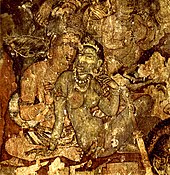

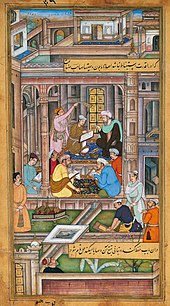
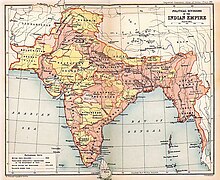

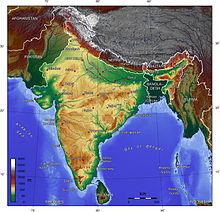

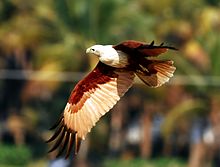
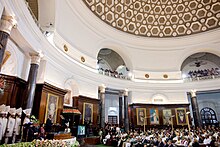
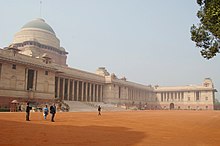
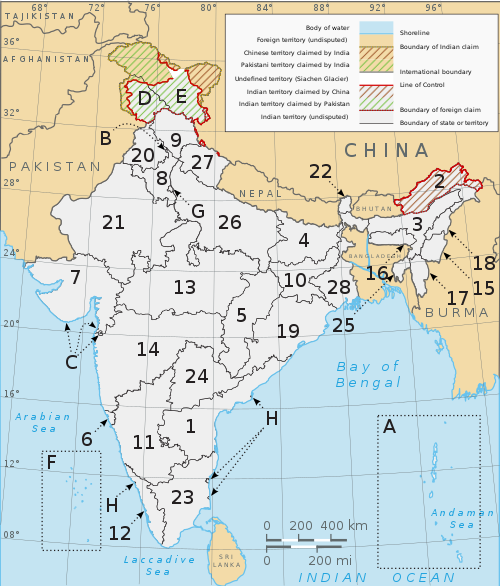

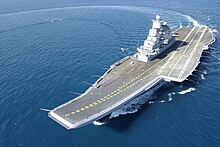




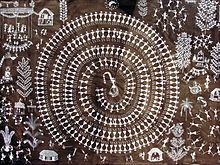
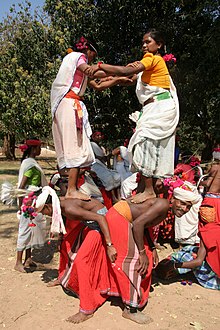

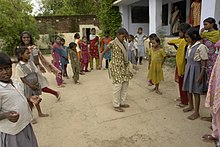
No comments:
Post a Comment